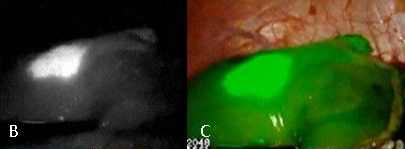Leading-edge equipment in precision laparoscopic surgery
Marsh 2019
The Jules Bordet Institute acquires leading-edge equipment in precision laparoscopic surgery.
The Jules Bordet department of surgery has acquired new laparoscopic equipment that includes the very latest system for visualising tissue by means of fluorescence imaging. This new system permits the detection of cancers such as hepatocarcinoma (liver cancer) and hepatic metastases as well as fluorescence-guided precision surgery.

A fluorescent product is injected intravenously into the patient to permit an assessment of the vascularization quality of the tissue. This makes it possible for a gastrointestinal surgeon to check the quality of a suture made following the resection of a part of the colon (colectomy) and to ensure that it is effectively vascularised. This also permits a more precise cutting of tissue and serves to avoid the risk of fistulas associated with a poor vascularisation.
Plastic surgeons can also use this high-tech equipment during surgery for breast reconstruction. In this case too the system allows the surgeon to assess the quality of the vascularization of the tissues (skin-muscle flap used to reconstruct the breasts) and thus attempt to prevent risks of necrosis.
Specifically, this new equipment makes it possible to combine two types of medical imaging in real time and in the same plane. During the actual surgery the surgeon has access both to conventional laparoscopic images (visualisation camera) of the organs and to fluorescent images. This enables the surgeon to guide his actions according to the veins that irrigate the tissue. Such as system of laparoscopy combined with very high precision medical imaging is currently available at just three Belgian hospitals.